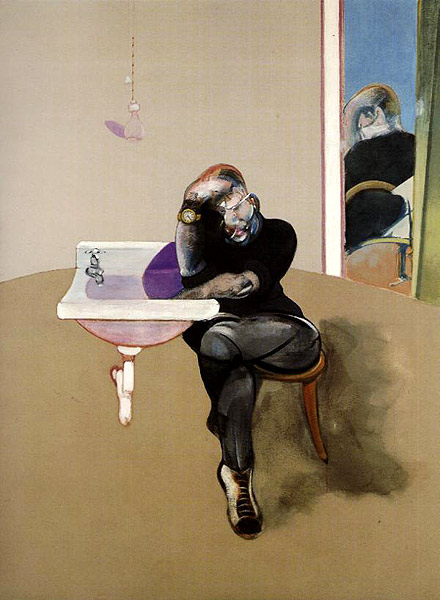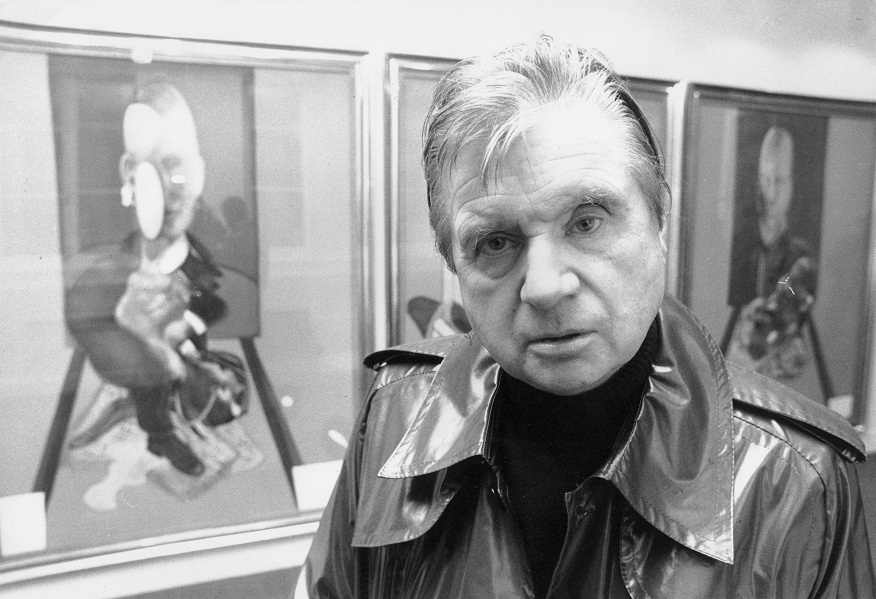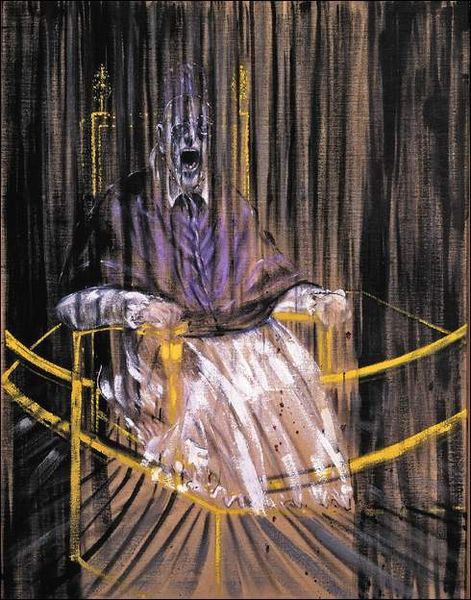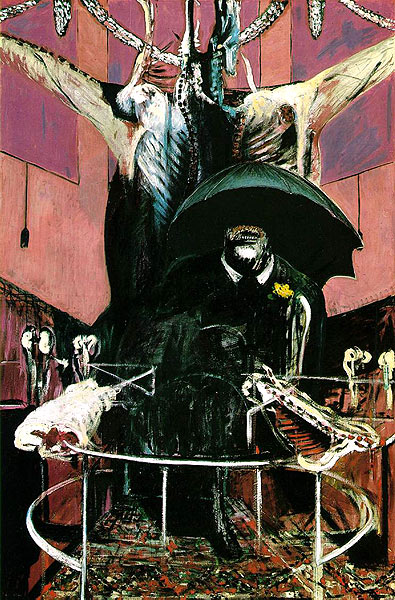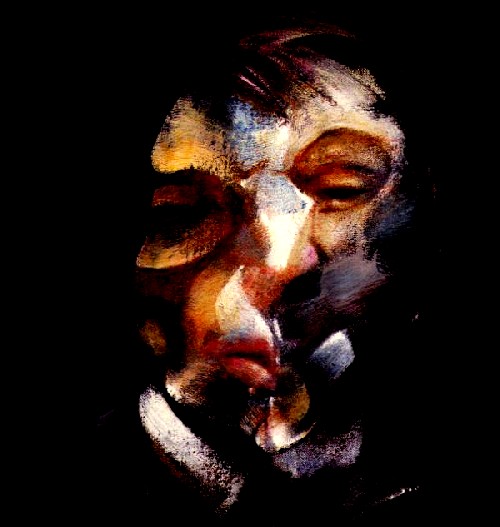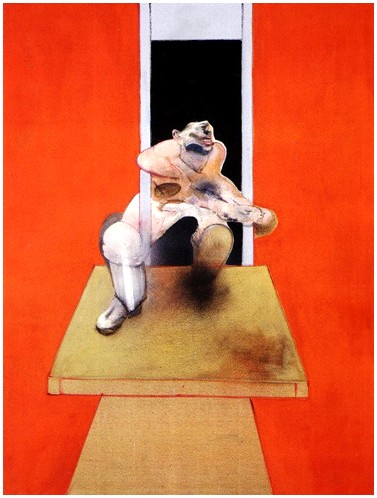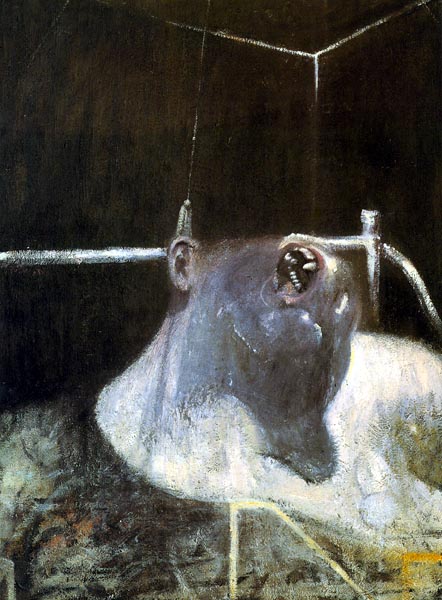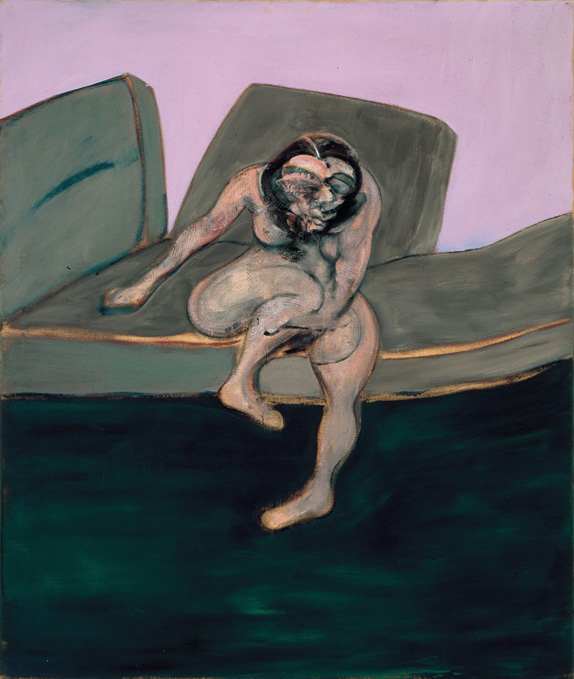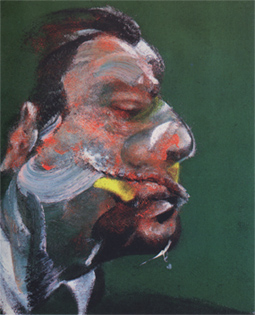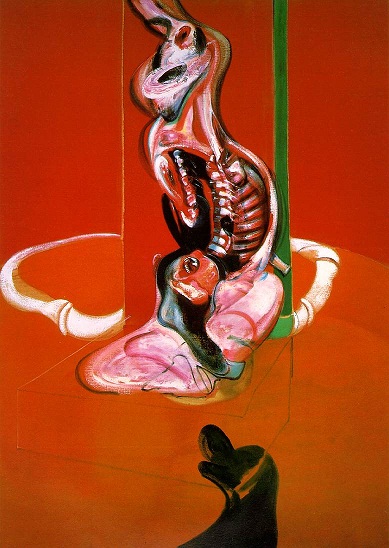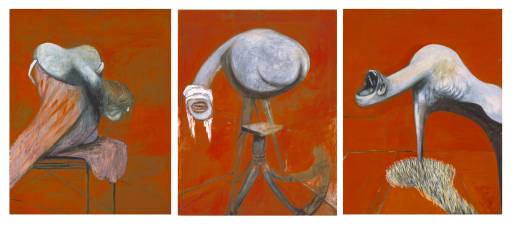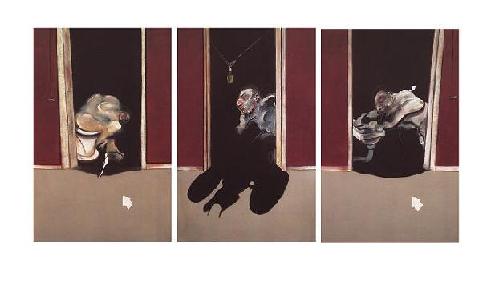<Back to Index>
- Mathematician Pierre François Verhulst, 1804
- Painter Francis Bacon, 1909
- 15th Edo Shogun Tokugawa Yoshinobu, 1837
PAGE SPONSOR

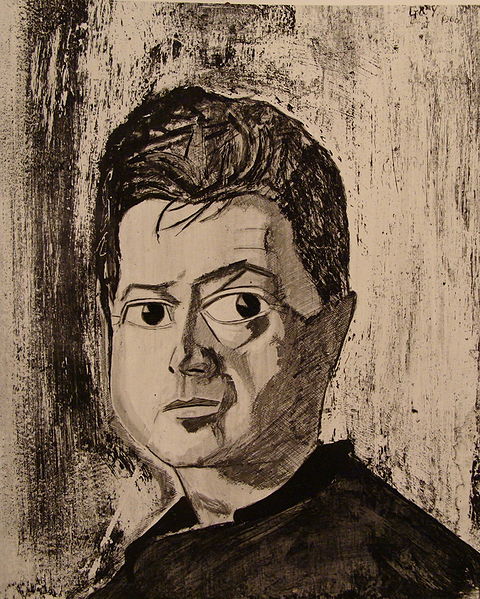
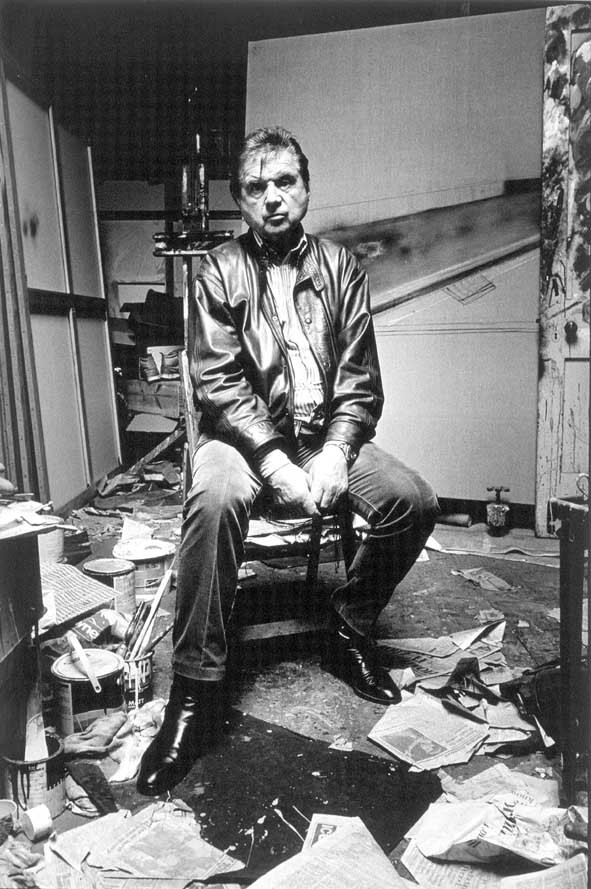
Francis Bacon (28 October 1909 – 28 April 1992) was an Anglo-Irish figurative painter known for his bold, austere, graphic and emotionally raw imagery. Bacon's painterly but abstract figures typically appear isolated in glass or steel geometrical cages set against flat, nondescript backgrounds. He began painting during his early 20s; yet he worked only sporadically until his mid 30s. Before this time he earned his living as an interior decorator and designer of furniture and rugs. Later, he admitted that his career was delayed because he had spent too long looking for a subject that would sustain his interest. His breakthrough came with the 1944 triptych Three Studies for Figures at the Base of a Crucifixion, and it was this work and his heads and figures of the late 1940s through to the early 1960s that sealed his reputation as a notably bleak, world famous, chronicler of the human condition.
From the mid 1960s, Bacon mainly produced portrait heads of friends. He often said in interviews that he saw images "in series", and his artistic output often saw him focus on single themes for sustained periods including his crucifixion, Papal heads, and later single and triptych heads series. He began by painting variations on the Crucifixion and later focused on half human-half grotesque heads, best exemplified by the 1949 "Heads in a Room" series. Following the 1971 suicide of his lover George Dyer, Bacon's art became more personal, inward looking and preoccupied with themes and motifs of death. The climax of this late period came with his 1982 "Study for Self - Portrait", and his late masterpiece Study for a Self Portrait - Triptych, 1985 - 86. Despite his seemingly existentialist outlook on life, Bacon appeared to be a bon vivant, spending much of his middle and later life eating, drinking and gambling in London's Soho with Lucian Freud, John Deakin, Daniel Farson, Patrick Swift, Jeffrey Bernard, Muriel Belcher and Henrietta Moraes, among others. Following Dyer's death he distanced himself from this circle and became less involved with rough trade to settle in a platonic relationship with his eventual heir, John Edwards.
Since his death, Bacon's reputation has steadily grown. While Margaret Thatcher famously described him as "that man who paints those dreadful pictures", he was the subject of two major Tate retrospectives during his lifetime and received a third in 2008. Bacon always professed not to depend on preparatory works and was resolute that he never drew. Yet since his death, a number of sketches have emerged and although the Tate recognised them as canon, they have not yet been acknowledged as such by the art market. In addition, in the late 1990s, several presumed destroyed major works, including Popes from the early 1950s and Heads from the 1960s, surfaced on the art market, some of which are considered equal to any of his "official" output.
Francis Bacon was born in Dublin at 63 Lower Baggot Street, to parents of British descent. Captain Anthony Edward Mortimer ("Eddy") Bacon, his father, was a veteran of the Boer War who became a racehorse trainer. Christina Winifred "Winnie" Firth, his mother, was an heiress to a Sheffield steel business and coal mine. It is believed that his father was a direct descendant of Sir Nicholas Bacon, the elder half-brother of Sir Francis Bacon, the Elizabethan statesman, philosopher and essayist. His beautiful great great grandmother, Lady Charlotte Harley, was intimately acquainted with Lord Byron, who called her "Ianthe", so much so that he dedicated his famous poem, Childe Harold's Pilgrimage, to her. When Bacon's paternal grandfather was given the chance to revive the family title of Lord Oxford by Queen Victoria, he refused for financial reasons. Bacon rarely discussed his illustrious roots, preferring to portray himself as an outcast destined to carve his own path in the world, which was an apt description, to a large extent. Bacon had an older brother, Harley, five years his senior, two younger sisters, Ianthe and Winifred, and a younger brother, Edward. He was raised by the family nanny, a Cornish woman named Jessie Lightfoot. A sickly child with asthma and a violent allergy to dogs and horses, Bacon was often given morphine to ease his suffering during attacks. The family shifted houses often, moving back and forth between Ireland and England several times during this period, leading to a feeling of displacement that would remain with the artist throughout his life. In 1911 the family lived in Cannycourt House near Kilcullen, County Kildare, but later moved to Westbourne Terrace, London, close to where Bacon's father worked at the Territorial Force Records Office.
On returning to Ireland after World War I, Bacon was sent to live for a time with his maternal grandmother and step grandfather, Winifred and Kerry Supple, at Farmleigh, Abbeyleix, County Laois. Eddy Bacon later bought Farmleigh from his mother-in-law, though they soon moved again to Straffan Lodge near Naas, County Kildare,
the birthplace of his mother. Although Francis was a shy child, he
enjoyed dressing up. This, coupled with his effeminate manner, often
enraged his father and created a distance between them. A story emerged
in 1992 of his father having had Francis horsewhipped by their groom. In 1924 his parents moved to Gloucestershire, first to Prescott House in Gotherington, then to Linton Hall, situated near the border with Herefordshire. Francis spent eighteen months boarding at Dean Close School, Cheltenham,
from the third term of 1924 until April 1926. This was to be his only
brush with a formal education as he quit the school right before he was
to be expelled. At a fancy-dress party at the Firth family house of Cavendish Hall, Suffolk, Francis dressed up as a flapper with
an Eton crop, beaded dress, lipstick, high heels, and a long cigarette
holder. In 1926 the family moved back to Ireland, and Straffan Lodge.
His sister, Ianthe (b. 1921), recalls that Bacon made drawings of
ladies with cloche hats and long cigarette holders. Later
that year, Francis was banished from Straffan Lodge following an
incident in which his father found him admiring himself in front of a
large mirror draped in his mother's underwear.
Bacon spent the autumn and winter of 1926 in London, with the help of an allowance of £3 a week from his mother's trust fund, living on his instincts, simply 'drifting', and reading Nietzsche. When he was broke, Bacon found that by the simple expedient of rent dodging and petty theft, he could manage a reasonable economy. To supplement his income, he briefly tried his hand at domestic service, but although he enjoyed cooking, he quickly became bored and resigned. He was sacked from a telephone answering position at a shop selling women's clothes in Poland Street, Soho, after writing a poison pen letter to the owner. Early on he was aware that he was able to attract a certain type of rich man, a fact he was quick to take advantage of, having developed a taste for good food and wine. One of the men was an ex-army friend of his father, another breeder of racehorses, named Harcourt-Smith. Bacon later claimed that his father had asked this friend to take him 'in-hand' and 'make a man of him'. Francis had a difficult relationship with his father, once admitting to being sexually attracted to him. Doubtless, Bacon was aware of his friend's reputation for virility, but not of his penchant for young men.
In the early Spring of 1927, Bacon was taken by Harcourt-Smith to the opulent, decadent, "wide open" Berlin of the Weimar Republic, where they stayed together at the Hotel Adlon. It is likely that Bacon saw Fritz Lang's Metropolis during this time. Bacon
spent two months in Berlin, though Harcourt-Smith left after just one —
"He soon got tired of me, of course, and went off with a woman... I
didn't really know what to do, so I hung on for a while, and then,
since I'd managed to keep a bit of money, I decided to go to Paris."
Bacon then spent the next year and a half in Paris. He met Yvonne
Bocquentin, pianist and connoisseur, at the opening of an exhibition.
Aware of his own need to learn French, Bacon lived for three months
with Madame Bocquentin and her family at their house near Chantilly. He traveled into Paris to visit the city's art galleries. At the Château de Chantilly (Musée Condé) he saw Nicolas Poussin's Massacre of the Innocents,
a painting to which he was often to refer in his own later work. From
Chantilly, he went to an exhibition that was largely to inspire him to
take up painting. His visit to a 1927 exhibition of 106 drawings by Picasso at the Galerie Paul Rosenberg, Paris, aroused his artistic interest, and he often took the train into
Paris five or more times a week to see shows and art exhibitions. Bacon
saw Abel Gance's epic silent film Napoléon at
the Paris Opéra when it premiered in April 1927. From the autumn
of 1927, Bacon stayed at the Paris Hôtel Delambre in Montparnasse.
Bacon returned to London late in 1928 or early 1929, and started work as an interior designer. He took a studio at 17 Queensberry Mews West, South Kensington, and shared the upper floor with Eric Alden - later to become his first collector - and his childhood nanny, Jessie Lightfoot. Bacon advertised himself as a "gentleman's companion" in The Times, on the front page (then reserved for personal messages and insertions). Among the many answers carefully vetted by Nanny Lightfoot was one from an elderly cousin of Douglas Cooper, at that time owner of one of the finest collections of modern art in England. The gentleman, having paid Bacon for his services, found him part time work as a telephone operator in a London club and further sought Cooper's help in promoting Bacon's developing skill as a designer of furniture and interiors. Cooper also commissioned a desk from Bacon in battleship gray around this time.
In 1929 he met Eric Hall at the Bath Club, Dover Street, where Bacon was working at the telephone exchange. Hall was to be both patron and lover to Bacon, in an often torturous relationship.
The first show in the winter of 1929, at Queensberry Mews, was of Bacon's carpet rugs and furniture (a rug was purchased by Hall), but may have included Painted screen (c.1929 – 1930) and Watercolour (1929), both bought by Eric Alden. Watercolour (1929) his earliest surviving painting, seems to have evolved from his rug designs, in turn influenced by the paintings and tapestries of Jean Lurçat. Sydney Butler (daughter of Samuel Courtauld and wife of Rab Butler) commissioned a glass and steel table and a set of stools for the dining room of her Smith Square house.... Bacon's Queensberry Mews studio was featured in the August 1930 issue of The Studio magazine, in a double page article entitled "The 1930 Look in British Decoration". The piece showed work including a large round mirror, some rugs and tubular steel and glass furniture largely influenced by the International Style, Marcel Breuer, Le Corbusier / Charlotte Perriand and Eileen Gray.
He returned to Germany in 1930. A dramatic studio portrait taken of Bacon by Helmar Lerski, a Swiss photographer and cinematographer, probably dates from this visit. Bacon was later to tell Stephen Spender that he had been very impressed by the work of a photographer who had produced striking effects using mirrors and natural light filtered through screens, but that he could not remember the artist's name. Later that year Francis Bacon met Roy de Maistre, an Australian painter who was to become a close friend and mentor. De Maistre's circle included Graham Sutherland, Henry Moore, Patrick White and Douglas Cooper. A second exhibition was held between 4 – 22 November at 17 Queensberry Mews. Alongside de Maistre and Jean Sheppeard, Bacon showed four paintings and one print. Gouache (1929) may be the piece titled as A Brick Wall in the hand-list. Painting (1929 – 1930) (probably the work listed as Tree by the Sea) is Bacon's earliest surviving oil painting. Both were bought by Alden. The two other paintings (Self-portrait and Two Brothers) and print (Dark Child in an edition of three) are now lost.
Bacon
left the Queensberry Mews West studio in 1931, and was not to have a
settled space for some years. Bacon probably shared a studio with Roy
de Maistre, about 1931 / 1932, at Carlyle Studios, (just off the Kings
Road), in Chelsea. Portrait (1932) and Portrait (c.1931 – 1932) (the latter bought by Diana Watson) both show a round faced youth with diseased skin (painted after Bacon saw Ibsen's Ghosts),
and date from a brief stay in a studio on the Fulham Road. In 1932,
Bacon was commissioned by Gladys MacDermot, an Irish woman who had
lived in Australia, to redesign much of the decoration and furniture of
her flat at 98 Ridgmount Gardens in Bloomsbury. Bacon recalled that she
was 'always filling me up with food'.
Bacon visited Paris in 1935, purchasing there a second hand book on diseases of the mouth containing high quality hand coloured plates of both open mouths and oral interiors, which haunted and obsessed him for the remainder of his life. In 1935 he saw Eisenstein's The Battleship Potemkin, the scene of the nurse screaming on the Odessa steps later becoming a major theme in his paintings, with the angularity of Eisenstein's image often combined with the thick red palette of his recently purchased medical tome.
In the Winter of 1935-6, Roland Penrose and Herbert Read, making a first selection for the International Surrealist Exhibition, visited his studio at 71 Royal Hospital Road, Chelsea, saw "three or four large canvases including one with a grandfather clock," but found his work "insufficiently surreal to be included in the show." Bacon claimed that Penrose had said to him "Mr. Bacon, don't you realize a lot has happened in painting since the Impressionists?" In 1936/7, Bacon moved from 71 Royal Hospital Road to the top floor of 1 Glebe Place, Chelsea, which Eric Hall had rented. The following year, White moved to the top two floors of the building where de Maistre now had his studio, on Eccleston Street, and commissioned from Bacon, who was by now a friend, a writing desk (with wide drawers and a red linoleum top). White also bought the glass and steel dining table from Rab and Sydney Butler.
In January 1937, at Thomas Agnew and Sons, 43 Old Bond Street, London, Bacon was in a group show, Young British Painters, which included Graham Sutherland, Victor Pasmore, and Roy de Maistre. Eric Hall, also a friend of Jerry Agnew, organized the show; Agnew's was then known for shows of Old Master paintings. Four works by Bacon were shown: Figures in a Garden (1936), purchased by Diana Watson; Abstraction, and Abstraction from the Human Form, known from magazine photographs (they prefigure Three Studies for Figures at the Base of a Crucifixion (1944) in variously having a tripod structure (Abstraction), bared teeth (Abstraction from the Human Form), and both being biomorphic in form); Seated Figure is lost entirely.
On 1 June 1940 Bacon's father died. Bacon was named sole Trustee and Executor of his father's will, which requested that the funeral be as 'private and simple as possible'.
Unfit for active service, Bacon volunteered for Civil Defence and worked full-time in the ARP (Air Raid Precautions) rescue service. But the fine dust of bombed London worsened his asthma and he was discharged. So, at the height of The Blitz, Eric Hall rented a cottage for Bacon and himself at Bedales Lodge, Steep, near Petersfield, Hampshire. Figure Getting Out of a Car (c. 1939 - 1940) was painted here but is known only from an early 1946 photograph taken by Peter Rose Pulham (taken shortly before it was painted over by Bacon and retitled Landscape with Car). An ancestor to the biomorphic form of the central panel of Three Studies for Figures at the Base of a Crucifixion (1944), the composition was suggested by a photograph of Hitler getting out of a car at one of the Nuremberg rallies, (Bacon claims to have "copied the car and not much else.")
Returning from Hampshire at the latter part of 1943, Bacon and Hall took the ground floor of 7 Cromwell Place, South Kensington, John Everett Millais' old house and studio. High vaulted and north lit, it had had its roof recently bombed - Bacon was able to adapt a large old billiard room at
the back of the house as his own studio. Nanny Lightfoot, lacking an
alternative location, slept on the kitchen table. Illicit roulette parties were held there, organized by Bacon with assistance by Hall, to the financial benefit of both.
Bacon considered his 1944 Three Studies for Figures at the Base of a Crucifixion (1944) as his fons et origo and did not want any of his earlier works to enter his canon. Graham Sutherland saw his Painting (1946) in the Cromwell Place studio, and urged his dealer, Erica Brausen, then of the Redfern Gallery, to go to see the painting and to buy it. Brausen wrote to Bacon several times, and visited his studio in early autumn 1946 and promptly bought the work for £200. (Painting (1946) was shown in several group shows including in the British section of Exposition internationale d'arte moderne (18 November - 28 December 1946) at the Musée National d'Art Moderne, for which Bacon travelled to Paris.)
Within a fortnight of the sale of Painting (1946) to the Hanover Gallery, with the proceeds, Bacon had decamped from London to Monte Carlo. After staying at a succession of hotels and flats, including the Hôtel de Ré, Bacon settled in a large villa, La Frontalière, in the hills above the town. Eric Hall and Nanny Lightfoot would come to stay. Bacon spent much of the next few years in Monte Carlo, short visits to London apart. From Monte Carlo, Bacon wrote to Graham Sutherland and Erica Brausen. His letters to Erica Brausen show that he did paint there, but no paintings are known to survive.
In 1948, Painting (1946) sold to Alfred Barr for the Museum of Modern Art in New York for £240. Bacon wrote to Sutherland asking that he apply fixative to the patches of pastel on Painting (1946) before it was shipped to New York. Painting (1946) is now too fragile to be moved from MoMA for exhibition elsewhere.
At
least one visit to Paris in 1946 brought Bacon into more immediate
contact with French post war painting and Left Bank ideas such as
Existentialism. He had, by this time, embarked on his life long friendship with Isabel Rawsthorne,
a painter closely involved with Giacometti and the Left Bank set. They
shared many interests including ethnography and classical literature.
Bacon returned to London and Cromwell Place to paint, late in 1948. Head I was shown at the Summer Exhibition at the Redfern gallery from July to September 1948. By the end of 1948 Erica Brausen, who had advanced Bacon money for works, left the Redfern Gallery. Brausen had found private capital to start her own gallery in Mayfair. In the spring, a Bacon painting, presumably Head I, was shown at her new Hanover Gallery (and was noted by Wyndham Lewis, as a preview of the main show, in an exhibition review of 12 May 1949). Held between 8 November and 10 December 1949 at the Hanover Gallery, Francis Bacon: Paintings; Robert Ironside: Coloured Drawings, was, in effect, his first professional one-man show (Robert Ironside's watercolors were on an upper floor). A series of six paintings Head I to Head VI, with Study from the Human Body (1949) and Study for Portrait (1949) formed the core of the show with four other paintings by Bacon. Bacon's paintings attracted the support of Wyndham Lewis writing in The Listener. "The Hanover [Gallery] Show is of exceptional importance. Of the younger painters none actually paints so beautifully as Francis Bacon", Lewis wrote, adding: "Bacon is one of the most powerful artists in Europe today and he is perfectly in tune with his time". The following year he wrote of another exhibition: "Three large new canvases by Bacon prove him once more to be the most astonishingly sinister artist in England, and one of the most original".
Well, I was living once down in Monte Carlo and I had lost all my money, and, I had no canvases left and so, the few I had I just turned them, and I found that the, that the, what is called the wrong side, the unprimed side of the canvas worked for me very much better. So I've always used them. So it was just by chance that I had no money to buy canvases with." - Excerpt from an interview with Melvyn Bragg in Francis Bacon (1985), for the South Bank Show for London Weekend Television.
Head II is,
for Bacon, very thickly painted, this was one of very few instances
when he had been able to 'rescue' a painting after it had become overworked and the weave of the canvas clogged (as happened with two abandoned works on canvas from the Head series, from 1949, also in the 1949 Hanover show). The arrow, or pointer, motif in Head II is taken from the book Positioning in Radiography by Kathleen Clara Clark, 1939. Head VI was Bacon's first surviving engagement with Velázquez's great Portrait of Pope Innocent X (three 'popes' were painted in Monte Carlo in 1946 but were destroyed). The Cobalt Violet mozzetta,
crimson in Velázquez's painting, may reflect Bacon's use of
printed reproductions of the painting. Bacon later said that, although
he admired "the magnificent color" of the Velázquez,
Velázquez "wanted to make it as much like a Titian as possible but, in a curious way he cooled Titian".
The Colony Room is a private drinking club at 41 Dean Street, Soho, also known as Muriel's after Muriel Belcher, the formidable proprietor. Belcher, who had run a club called the Music-box in Leicester Square during the war, had secured a 3pm - 11pm drinking licence for the Colony Room bar as a private members club (public houses had to, by law, close at 2:30pm). Bacon was a founding member, and joined the day after its opening in 1948. He was 'adopted' by Belcher as a 'daughter', and was allowed free drinks and £10 a week to bring in friends and rich patrons. It was here that Bacon became friends with Lady Rose McLaren.
Bacon met the painter and illustrator John Minton in 1948. Minton was soon to become a regular at 'Muriel's, as were the painters Lucian Freud, Frank Auerbach, Timothy Behrens, Michael Andrews, the two Roberts, Colquhoun and MacBride, and above all the sometime Vogue photographer, John Deakin. In 1950, Bacon met the art critic David Sylvester, then best known for his writing on Henry Moore and praise for Alberto Giacometti's work. Sylvester had admired and written about his work (first writing about Bacon for a French periodical, L'Age nouveau, in 1948) but had erroneously perceived it to be a form of Expressionism. Head I, in particular, at the 1949 Hanover Gallery show, was, for Sylvester, proof of Bacon's importance as a painter. John Minton left for the West Indies in September 1950. Aware that Bacon was in need of money, Minton asked him to take over his post as a tutor at the school of painting at the Royal College of Art. On condition that he did no formal teaching, Bacon agreed. So for three months, he was on hand to talk to the students for two days a week. In 1960 Bacon met the then young Irish painter Reginald Gray who painted a small egg tempera on wood portrait of Bacon. The work was the first portrait of Bacon to enter The National Portrait Gallery London when in 1975 it was gifted to the Gallery by the collector Aubrey Beese.
By 1950, Bacon's affair with Eric Hall had come to an end - he no longer appears on the electoral register with Bacon and Jessie Lightfoot at 7 Cromwell Place - but he was to remain a loyal patron, friend and supporter. During November 1950, Bacon visited his mother in South Africa. This suited his asthma better than spending winter in London. Bacon was impressed by the African landscapes and wildlife, and took photographs in Kruger National Park. On his return journey he spent a few days in Cairo, and wrote to Erica Brausen of his intent to visit Karnak and Luxor, and then go via Alexandria to Marseilles. The visit confirmed his belief in the supremacy of Egyptian art, embodied by the Sphinx. He returned in the Spring of 1951.
On 30 April 1951, Jessie Lightfoot, Bacon's childhood nurse, died at Cromwell Place. Bacon was gambling in Nice when
he learnt of her death. Lightfoot was Bacon's closest companion and had
joined him in London on his return from Paris, and lived with him and
Eric Alden at Queensberry Mews West, and later with him and Eric Hall
at the cottage near Petersfield, in Monte Carlo and at Cromwell Place.
Stricken, Bacon sold the 7 Cromwell Place apartment.
Francis Bacon met George Dyer in 1964 when, he claimed, he caught the young man breaking into his home. Dyer was then about thirty years old and had grown up in the East End of London in
a family steeped in crime. He had spent his life drifting between
theft, juvenile detention center and jail. Typical of Bacon's taste in
men, Dyer was fit, masculine, and not an intellectual. Bacon's
relationships prior to Dyer had all been with older men who were as
tumultuous in temperament as the artist himself, but each had been the
dominating presence. Peter Lacy, his first lover, would often tear up
the young artist's paintings, beat him up in drunken rages, and leave
him on the street half-conscious. Bacon
was attracted to Dyer's vulnerability and trusting nature. Dyer was
impressed by Bacon's self-confidence and his artistic success, and
Bacon acted as a protector and father figure to the insecure younger man. Dyer
was, like Bacon, a borderline alcoholic and similarly took obsessive
care with his appearance. Pale faced and a chain smoker, Dyer typically
confronted his daily hangovers by drinking again. His compact and
athletic build belied a docile and inwardly tortured personality; the
art critic Michael Peppiatt described
him as having the air of a man who could "land a decisive punch". Their
behaviours eventually overwhelmed their affair, and by 1970, Bacon was
merely providing Dyer with enough money to stay more or less
permanently drunk.
As Bacon's work moved from the extreme subject matter of his early paintings to portraits of friends in the mid 1960s, Dyer became a dominating presence in the artist's work. Bacon's treatment of his lover in these canvasses emphasises his subject's physicality while remaining uncharacteristically tender. More than any other of the artist's close friends portrayed during this period, Dyer came to feel inseparable from his effigies. The paintings gave him stature, a raison d'etre, and offered meaning to what Bacon described as Dyer's "brief interlude between life and death". Many critics have cited Dyer's portraits as favourites, including Michel Leiris and Lawrence Gowling. Yet as Dyer's novelty diminished within Bacon's circle of sophisticated intellectuals, the younger man became increasingly bitter and ill at ease. Although Dyer welcomed the attention the paintings brought him, he did not pretend to understand or even like them. "All that money an' I fink they're reely 'orrible", he observed with choked pride. He abandoned crime but soon descended into alcoholism. Bacon's money allowed Dyer to attract hangers-on who would accompany him on massive benders around London's Soho. Withdrawn and reserved when sober, Dyer was insuppressible when drunk, and would often attempt to "pull a Bacon" by buying large rounds and paying for expensive dinners for his wide circle. Dyer's erratic behaviour inevitably wore thin — with his cronies, with Bacon, and with Bacon's friends. Most of Bacon's art world associates regarded Dyer as a nuisance — an intrusion into the world of high culture to which their Bacon belonged. Dyer reacted by becoming increasingly needy and dependent. By 1971, he was drinking alone and was only in occasional contact with his former lover.
In October 1971, Dyer accompanied Bacon to Paris for the opening of the artist's retrospective at the Grand Palais.
The show was the high point of Bacon's career to date, and he was now
being described as Britain's "greatest living painter". Dyer was now a
desperate man, and although he was "allowed" to attend, he was well
aware that he was "slipping", in every sense, out of the picture. To
draw Bacon's attention he earlier planted cannabis in Bacon's flat,
then phoned the police, and he had attempted suicide on a number of occasions. On
the eve of the Paris exhibition, Bacon and Dyer shared a hotel room,
and Bacon spent the next day surrounded by people eager to meet him. In
mid evening he was informed that Dyer had taken an overdose of barbiturates and
was dead. Though devastated, Bacon continued with the retrospective and
displayed powers of self-control "to which few of us could aspire", according to Russell. Bacon
was deeply affected by the loss of Dyer, and he had recently lost four
other friends and his nanny. From this point on, death haunted his life
and work. Though
he gave a stoic appearance at the time, he was inwardly broken. He did
not express his feelings to critics, but later admitted to friends that
"daemons, disaster and loss" now stalked him as if his own version of
the Eumenides. Bacon
spent the remainder of his stay in Paris attending to promotional
activities and funeral arrangements. He returned to London later that
week to comfort Dyer's family. The funeral proved to be an emotional
affair for all, and many of Dyer's friends, including hardened East-End
criminals, broke down in tears. As the coffin was lowered into the
grave one attendant screamed "you bloody fool!". Although Bacon
remained stoic throughout, in the following months Dyer preoccupied his
imagination as never before. To confront his loss, he painted a number
of tributes on small canvasses and his three "Black Triptych"
masterpieces.
In 1974, Bacon met John Edwards, a young, illiterate Eastender with whom he formed one of his most enduring friendships.
Bacon died of a heart attack on 28 April 1992 while on holiday in Spain. He bequeathed his entire estate (then valued at £11 million) to John Edwards. Edwards, in turn, donated the contents of Francis Bacon's chaotic studio at 7 Reece Mews, South Kensington, to the Hugh Lane Gallery in Dublin. Bacon's studio contents were moved and the studio carefully reconstructed in the gallery. Additionally draft materials, perhaps intended for destruction, were bequeathed to Barry Joule who later forwarded most of the materials to create the Barry Joule Archive in Dublin with other parts of the collection given later to the Tate museum.
The tiny and cramped nature of Bacon's London studio and apartment were subjected to some critical analysis in an article in The Guardian by
Aida Edemariam. She claims Bacon being frequently locked screaming for
hours in a cupboard as a young boy, by a nanny, formed the basis of his
preference for working in cramped conditions and his unwillingness to
work in a larger space. The article states: "That cupboard," Bacon
apparently said years later, "was the making of me."
The imagery of the crucifixion weights heavily in the work of Francis Bacon. The critic John Russell wrote that the crucifixion in Bacon's work is a "generic name for an environment in which bodily harm is done to one or more persons and one or more other persons gather to watch". Bacon admitted that he saw the scene as "a magnificent armature on which you can hang all types of feeling and sensation". He believed that the imagery of the crucifixion allowed him to examine "certain areas of human behaviour" in a unique way, as the armature of the theme had been accumulated by so many old masters. Though he came to painting relatively late in life - he did not begin to paint seriously until his late 30s, crucifixion scenes can be found in his earliest works. In 1933, his then patron Eric Hall commissioned a series of three paintings based on the subject. These early paintings were influenced by such old masters as Matthias Grünewald, Diego Velázquez and Rembrandt, but also by Picasso's late 1920s and early 1930s biomorphs and the early work of the Surrealists.
The
open mouth was a motif which fascinated the artist from early in his
career; the theme is examined in one of his first surviving works, Abstraction from the Human Form. By the early 1950s it became an obsessive concern, to the point, according to art critic and Bacon biographer Michael Peppiatt,
"it would be no exaggeration to say that, if one could really explain
the origins and implications of this scream, one would be far closer to
understanding the whole art of Francis Bacon." The
inspiration for the recurring motif of the screaming mouths in many
Bacon's of the late 1940s and early 1950s were drawn from a number of
sources, including medical text books, the works of Matthias Grünewald and photographic stills of the nurse in the Odessa Steps scene in Sergei Eisenstein's 1925 silent The Battleship Potemkin.
Bacon first saw the film in 1935, and viewed it frequently thereafter.
In his studio, he kept a photographic still of the scene which showed a
close-up of the nurse's head which showed her screaming in panic and
terror and with broken pince-nez spectacles
hanging from her blood stained face. He referred to the image
throughout his career, using it as a source of inspiration.
Bacon's Soho life was portrayed by John Maybury, with Derek Jacobi as Bacon and Daniel Craig as George Dyer (and with Tilda Swinton as Muriel Belcher), in the film Love Is the Devil (1998), based on Daniel Farson's 1993 biography The Gilded Gutter Life of Francis Bacon.
On 14 May 2008, the Triptych, 1976, “a landmark of the 20th-century canon,” sold at Sotheby's contemporary art sale for €55.465 million ($86.28 million), a record for the artist and the highest price ever paid for a post war work of art at auction. Sold by the Moueix family, producers of Château Pétrus wines, it was bought by the Russian billionaire Roman Abramovich. The sale broke the 2007 record for his work of €34.212 million ($52.68 million). The triptych had remained in the same European collection since its 1977 purchase from a London gallery.
A major retrospective of Bacon's work opened on 11 September 2008 at Tate Britain, London. It was billed as the largest retrospective of his work ever mounted, containing around sixty of his works. In January 2009, it travelled on to the Prado Gallery in Madrid, Spain, where it was exhibited until April 2009. Then it travelled on to the Metropolitan Museum of Art in New York, "where it ended in the summer of 2009."
